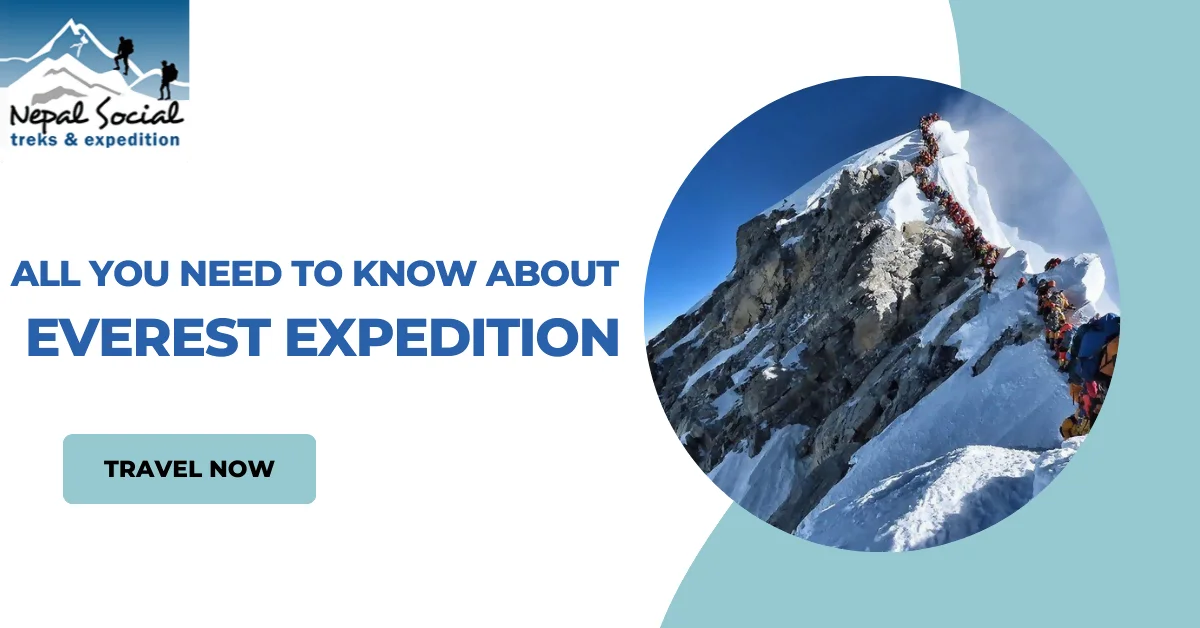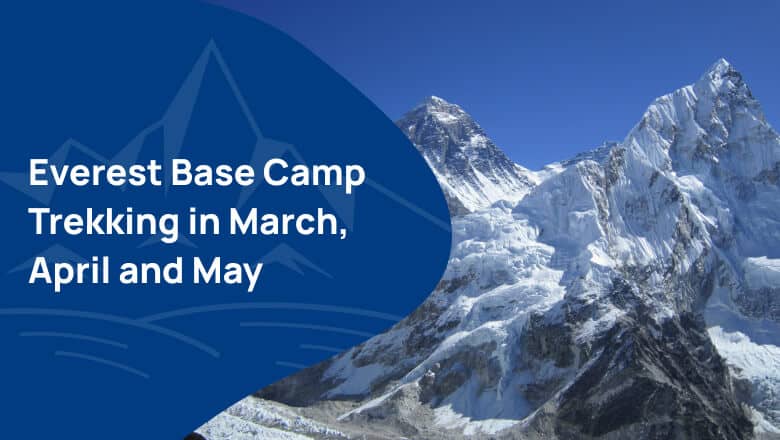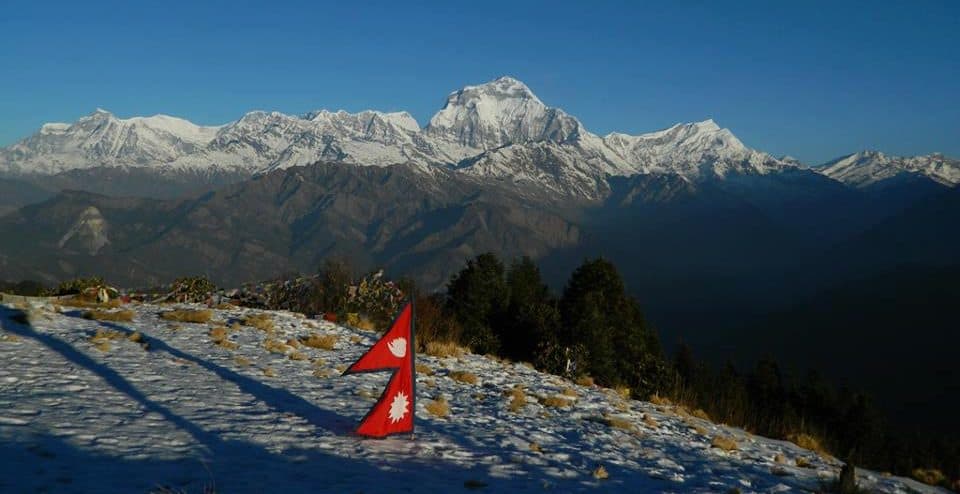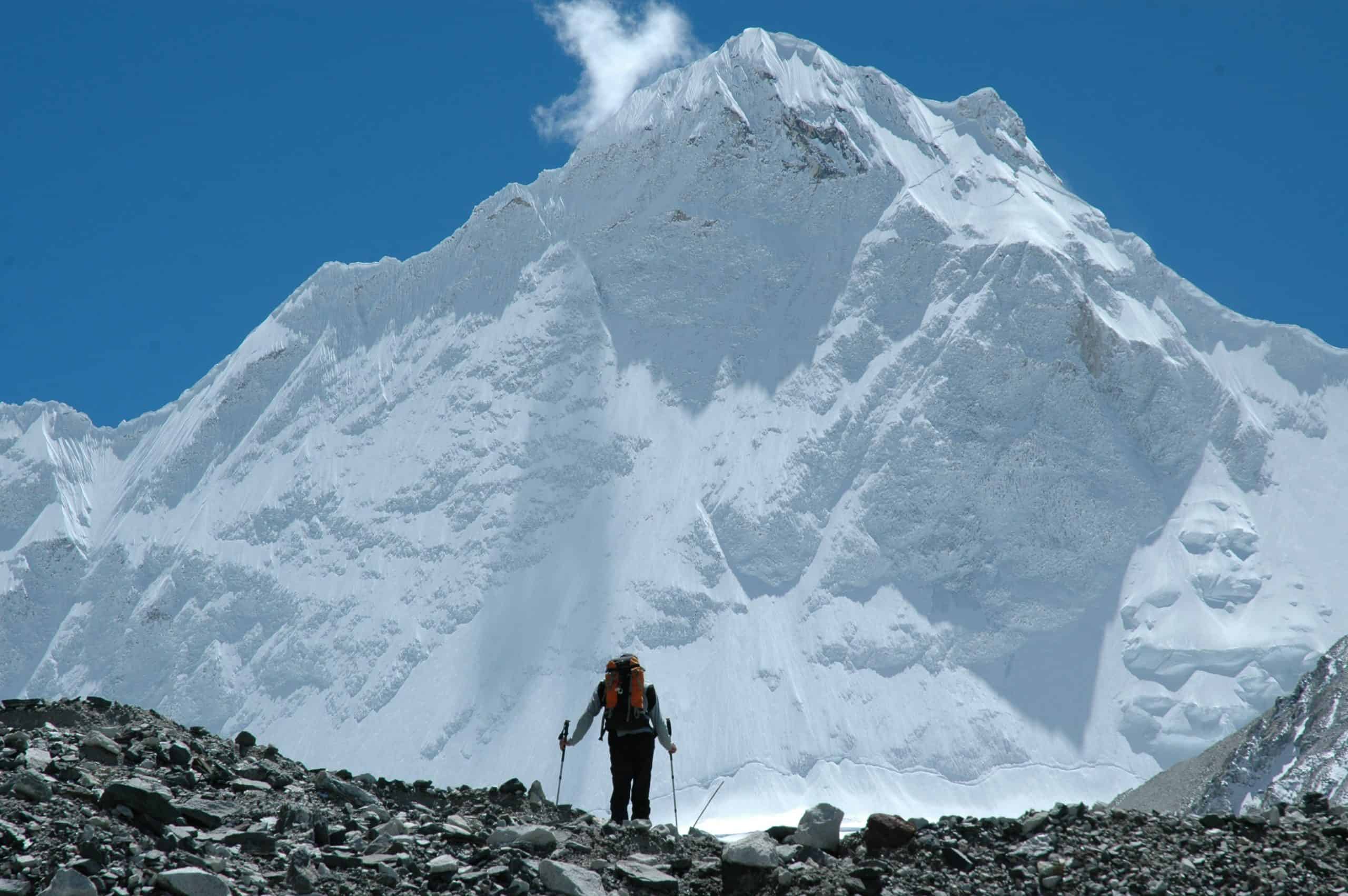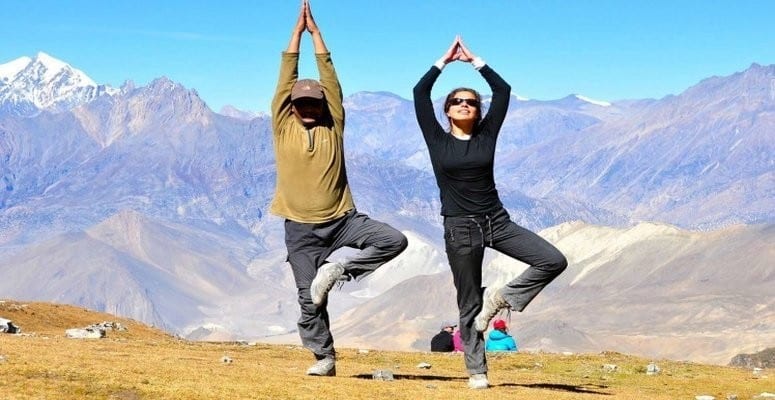Contents
- Introduction
- Getting Ready for Everest: Training Tips
- Mental Preparation: Overcoming Challenges on Everest
- Essential Gear for Climbing Everest
- Staying Safe: Risks and Safety Measures on Everest
- Capturing Everest: Photography Tips
- Understanding Altitude: Effects on Everest Climbers
- The History of Everest Climbs: Then and Now
- Meet the Sherpas: Key Players on Everest Expeditions
- Caring for Everest: Environmental Practices
- Reflections on Climbing Everest: Lessons and Memories
- Conclusion
Introduction
The Mount Everest expedition is an adventure one can dream of doing. Especially in mountaineering, it is an adventure that every climber wishes to do once in a lifetime. Before heading on to the top of the mount Everest you have to determine from which base you will start from. Basically, you can approach the top of the mountain on two sides – The south side and the North side. These two are the sides that are located in different countries, the South side is located in Nepal and the North side is located in Tibet.
Most of the people chose the southern side to do the Everest expedition, which was the same side that was chosen by the legendary Sir Edmund Hillary and Tenzing Norgay Sherpa. Although there are different paths to reach the top, we recommend every mountaineer approach from this side, as it offers more adventure and great views of the landscapes. However, if you want more comfort, then you can choose the northern side for the expedition.
Although you have these options to choose to do the Everest expedition, know that it ain’t gonna be that easy. This is one of the most challenging adventures in the world that normal people can do. The Everest expedition requires the climbers to have a stone-like mentality with hard determination, physical excellence, top-quality gear and Equipment, and the ability to acclimatize at high altitudes with high motivation.
Therefore to have all of these qualities, today we will give you brief advice on all of the topics in this guide. Having plenty of information as a mountaineer is never a waste. In fact, gaining information before you head to the top of the mountain will make you prepare and put ahead in the game more than others. So keep patience and head through the following sections-
Getting Ready for Everest: Training Tips
Before heading to the Everest expedition, we want you to climb a couple of mountains in the Himalayas. It’s because as you head out with not enough experience, you will be too reliant on mountaineering guides. Usually, you can choose to do a 7000-meter peak climb. But even after doing the 7000-meter climb, it will be best for you to do an 8000-meter climb. The more you do in the high mountains, the more experience you will gain. We highly consider you doing Mera Peak, Island Peak, Lobuche Peak, and Cho-Oyu Peak. After doing multiple climbs, you will minimize your exposure to risks.

Training required to do Everest Expedition
To Prepare for the Everest summit climb, we would like to advise that you consult with professionals. In order to successfully complete the expedition you have to be physically fit. As per standard, we can divide the training into three phases 1st, 2nd and 3rd phase. In the first phase of training, you will do training for 6 days a week with one day being completely rest.
You can get started with jogging, lifting weights, walking uphill on a treadmill, and stair training. After training for 1 hour a day for 6 days, you will slowly get comfortable. As soon as you are comfortable doing the exercise. you can slowly increase the length of the workout and make it 2 hours a day.
Think about the plan for 1 year. As soon as you do the weight training, you will now have to head to the outdoor adventure with the backpack with some weights. Start with 10 kilograms and slowly increase the weights to 30 kilograms. As you will start with 4 hours of trek you can slowly increase the trekking hours to 10 hours. In the span of a year, you can achieve all of these things.
Mental Preparation: Overcoming Challenges on Everest
Climbing Everest is not only physically hard but also mentally hard. While doing this adventure you will have to be mentally strong as you will have to deal tackle different kinds of obstructs in the journey. To prepare yourself mentally, you can do Meditation, positive talk with yourself, and visualize yourself in the midst of the summit route. Here are some important mental preparation tips to overcome the challenges of the Everest Expedition-
Developing an Upbeat Attitude
Developing an optimistic outlook helps in becoming ready for upcoming difficulties.
Having an optimistic attitude all the time helps you to see the world in a different way. It helps you to make you ready for all kinds of challenges. In addition to an optimistic attitude, you can also use affirmations, knowing that training your mind can eventually strengthen your body. By having affirmations in your mind you will be feeling different kinds of power in your mind.
Affirmations like ” I am going to finish this journey soon” “I will keep it easy going” than “Is it possible for me to get to top” “Would i be able to make it to the top?” is very different. You shouldn’t be doubting yourself on this journey. Once you self-doubt yourself the chance of making to top will get low. Therefore, we want to see you fight your negative beliefs and replace them with positive ones by repeating them over and over in your mind. Follow the best approach with a positive mindset then you will be all good.
Visualization
Professional athletes have been using visualization as a critical tool for decades. It is the act of seeing in your mind’s eye what you would like to come to pass.
One of the best methods for people to achieve success is visualization. It is the method that many athletes have used for decades. Basically, visualization is the process where the person likes to see himself in the future. While on the Everest expedition, you have to visualize yourself on the top of the summit surrounding you with taller mountains. Imagine that being in such a situation will make your life complete and you will make any effort to fulfill that dream.
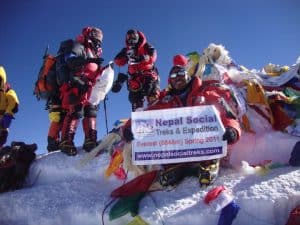
Hence, know that the Everest expedition is one of the toughest adventures. And while heading onto such a trip encountering obstacles is usual and necessary for the exciting adventure. Therefore, to confront and overcome them, you should be mentally ready and have a stone-like hard mentality with great persistence and determination.
Essential Gear for Climbing Everest
Here we have listed the detailed gears and equipment that will be needed while you do the Everest Expedition. Our multiple mountaineering trips to the Himalayas have given the enough experience to our guides so that we are able to list these items and make them available to you. So check out this information clearly and discuss it with your guide or agency before heading to the Everest expedition.
Climbing Equipment
- Ice axe
- Accessory cord
- Crampons
- Carabiner system
- Alpine climbing harness
- Belay device plus 1 locking carabiner
- Rappel/belay device
- Trekking poles
- Ascender
Footwear
- High-altitude all-in-one boot
- Camp boots
- Insulated camp booties
- Light hiking boots or trekking shoes
- Wool or synthetic socks
- Liner socks
Technical clothing
- Short underwear
- Baselayer tops & bottoms
- Long sleeve sun shirt
- Trekking pants
- Softshell pants
- Hardshell pants
- Softshell jacket
- Midlayer top
- Hardshell jacket
- Lightweight insulated jacket
- Insulated down parka
- Expedition down parka
- Expedition down pants
- Down suit
- Insulated synthetic pants
Handwear
- Lightweight liner gloves
- Softshell gloves
- Insulated shell gloves
- Expedition mittens
Headwear
- Climbing helmet
- Buff
- Sun hat
- Balaclava system
- Wool/synthetic ski hat
- Facemask
- Glacier glasses
- Ski goggles
- Nose guard
- Headlamp
Personal Equipment
- -20°f down sleeping bag
- -40°f down sleeping bag
- Foam pad
- Inflatable sleeping pad
- 55-liter climbing pack
- Water bottles
- Thermos
- Water bottle parkas
- Mug
- Knife
- Pee bottle
- 0.5l nalgene bottle (optional)
- Bowl
- Spoon
- Pee funnel (for women)
- Trash compactor/contractor bags
- Camera
- Large duffel bags
- Solar panel + power bank (optional)
- Toiletry bag
- Water treatment tools
- Sunscreen
- Lipscreen
- Running shoes
- Altimeter/smartwatch (optional)
- Small personal first-aid kit
- Medications & prescriptions
- Hand sanitizer
- Face mask (optional)
- Shower gear
- Base camp comforts
- Hand and toe warmers
- Food
Traveling
- Travel clothes
- Small backpack
Except in cases where it is indicated as optional, every item on the list is necessary. Should you come without bringing any of them, you will have to find them on your own, which can be challenging and expensive, before the climb. We’ve chosen our top picks, which we heartily suggest to you. Kindly select goods similar to these, though they don’t have to be the same.
Except for some of the items on this list, most of the items are necessary for the Expedition. After figuring out the necessary items for the expedition you can select the top picks for you that are of high quality.
Staying Safe: Risks and Safety Measures on Everest
While heading on the Everest expedition, mountaineers must deal with plenty of risks. So to overcome the risks of this grand mountain expedition, climbers have to gain expert training that includes tactics for how to overcome the risk of the Everest expedition journey.
The major risk while doing the Everest expedition is above 8000 meters which is also described as a death zone. This is also the most dangerous section of the expedition. Furthermore, as you have to go through icy routes you will encounter multiple crevasses that might overwhelm the climbers. Also, the risk of Avalanches and falls is prominent in this region, due to which many people lose their lives.
In addition, the state of Mount Everest has been significantly impacted by climate change. Additional risks associated with climbing Mount Everest include oxygen deprivation and fever which we will discuss in the coming sections. For now, know that success in mountaineering can only come from appropriate training and management.
Crevasses
While on Expedition you can see lots of cracks defined as crevasses in glacial ice. Mostly, you will see the crevasses through the paths of Khumbu Icefall. In case when a climber falls into crevasses, the climbers and guides fix ropes between the paths and save the life of the climbers.
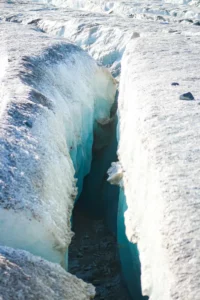
Uncertain Weather
The weather is mysterious in the Everest region. So, Everest climbing becomes significantly more challenging as a result. The weather around Mount Everest can change dramatically in a matter of hours, and you never know what’s going to happen. As a result, many climbers who want to complete the Everest Expedition start their climb in ideal weather only to avoid unexpected storms.
In a matter of certain hours, the pretty weather on the route can turn into snow with scary winds that could be life-threatening to climbers. So for that reason, you have to be ready with the gears and equipment and with a plan. Therefore, know that the presence of climbers doesn’t mean you will be safe.
Oxygen Deprivation
An oxygen supplement is very essential during the Everest expedition, especially when ascending to elevations of 8000 meters and higher. Know that the only people who can climb Everest without using additional oxygen are the most experienced mountaineers. Therefore, climbers must exercise extreme caution because there is a risk of cognitive impairment and brain cell damage for any climber who is oxygen-depleted.
Psychological condition
Your Everest expedition may also be impacted by other factors, like as neurological and psychological issues. The adventure may be affected by climbers’ poor decision-making. Hypoxia is the term used to describe when the brain does not get enough oxygen. It may significantly hinder judgment. As such, it is the most dangerous part of Mount Everest.
Freezing temperatures
In the Everest region, temperatures are consistently extremely cold at higher levels. Every 100 meters, the temperature decreases by 0.65 degrees Celsius as you continue your journey. Finally, at the summit of Mount Everest, the temperature will be roughly 57 degrees Celsius lower than it is at sea level.
When extreme hurricane-force winds and storms are thrown in, the temperatures become even more problematic while on the Everest expedition.
Khumbu icefall
Created by the Khumbu glacier, the Khumbu icefall is another barrier on the route to the summit of Everest. As they move so quickly, climbers have to dodge through large cracks that appear out of nowhere. The sudden collapse of large ice slabs known as seracs makes this method somewhat difficult. This approach can be difficult because the large ice slabs known as seracs might collapse suddenly.
Fact – Massive ice chunks have come out from the glacier. The glacier drips down 0.9 to 1.2 m (3 to 4 ft) of ice on average per day.
Avalanche
Avalanches are a major risk on the slopes of Mount Everest. There are several locations where there is a fairly significant risk of avalanches. The North Col and the South Col are the two areas of the mountain that are most vulnerable to avalanches. In addition, Khumbu Ice Falls is notoriously referred to as “Suicide Passage” due to its numerous avalanches.
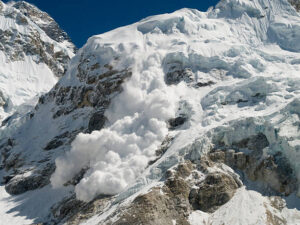
As you are aware, avalanches happen often. Avoid areas that have a lot of snow. After reaching the Lhotse Wall (also called the North Wall), you should climb rapidly as it is prone to avalanches. You should seek the aid of team leaders and certified guides as it is dangerous to walk in these conditions.
Climbers
The overwhelming number of mountaineers and climbers in the region raises yet another risk concern for Everest expeditions. On the Everest trail, countless pictures have been taken of climbers and mountaineers lining up at Hillary’s step. At the bottom of “Hillary Step” is a steep rock face. Here, it can be quite challenging because only one climber may pass at a time and everyone else has to wait in a long queue in extremely cold conditions.
Capturing Everest: Photography Tips
Capturing images of Mount Everest requires more than just capturing the landscape. It involves gathering the appropriate gear and maintaining the equipment. Standard portable or phone cameras will not work at high altitudes, so it is best to upgrade and spend the extra money to ensure that one can shoot the best images.
Digital Cameras
If you want to avoid sacrificing image quality, getting a full-frame DSLR is the best choice, especially if it’s mirrorless. A DSLR with wide-angle lenses is the best option because it can capture landscape and panoramic shots with much more detail than the other cameras. Investing in polarizing filters for cameras is also very advised, as they reduce glare and raise the possibility of capturing stunning images of Mount Everest.
The great ambient light in Everest makes most photographers want to shoot in AV mode (aperture priority) for optimal results.
What Photographers Should Take of Mount Everest
There are many places on Mount Everest expedition where one can capture amazing photos, but most hikers and climbers are usually too high on adrenaline to notice when such opportunities arise. Photographers are allowed to capture anything they want, however the following are some recommended shots:
Sunrise and sunset
Nothing beats the captivating moment when the sun sets and crosses over the snow-capped peaks of Mount Everest, even though it’s quite romantic. When combined, the sight is so amazingly amazing and surreal that it takes photographers several minutes to gather their thoughts before they even think about picking a camera.
Starry Sky at Night
A breathtaking 360-degree view of the night sky is accessible to climbers who visit in late May and remain through June. Imagine the closest possible view of the night sky: millions of dazzling stars that periodically appear to fall and increase upon Earth.
Understanding Altitude: Effects on Everest Climbers
Altitude Sickness
Overcoming acute mountain sickness is one of the hardest aspects of any high-altitude peak-climbing adventure. Additionally, the Mt. Everest expedition makes this very evident. Climbers are affected because the air pressure and oxygen content in the surroundings are reduced. After a certain point, most climbers will require more oxygen to continue on the route.
Thus, acclimating to base camp and beyond will require climbers to dedicate a substantial amount of time. If treatment for altitude sickness is postponed, Everest climbers may be at risk for this potentially lethal condition. A significant amount of time may be spent acclimating to the environment in one of the various camps along the Everest route.
High Altitude Pulmonary Edema (HAPE) and High Altitude Cerebral Edema (HACE) are two symptoms of altitude sickness. In some cases, cerebral blood vessel explodes with fluid resulting in neurological deterioration and potential coma. As a result, it’s essential to regularly adapt and obtain enough sleep.
Also, there are numerous acclimatization sites in the surrounding region. You should also make your way down to a lower elevation where you can spend the night. Your body will adjust to high-altitude conditions more quickly if you do this. Additionally, anti-nausea drugs like Diamox can help with the symptoms of acute mountain sickness in the region.
The History of Everest Climbs: Then and Now
In 1921, the first-ever official ascent of Mount Everest took place. Nevertheless, two of the expedition’s attempts to climb Mount Everest in 1921 and 1922 were not successful. Afterward, in 1924, two members of the British expedition team, Andrew Irvine and George Mallory, came very close to completing the ascent. They were only 800 feet from the top before bad weather carried them away. Despite the fact that Mallory’s body was eventually discovered in 1999, no evidence was discovered on him to support the theory that he or Irvine had truly reached the top. The mystery hasn’t been solved as of yet.
First successful Climb of Mount Everest
Edmund Hillary of New Zealand and Tenzing Norgay, a Sherpa from Nepal, became the first people to climb to the top of Mount Everest on May 29, 1953. Hillary and Norgay were part of a British expedition led by Colonel John Hunt. This is the most prominent event in the history of mountain climbing. Both of them have already left this world, but their legacy will always be remembered in the world.
Climbing Mount Everest in present Condition
To this date, we think that there have been over 7000 climbers. Per the latest data as of July 2022, 6098 were successfully able to complete the ascent to Mount Everest. Per year nearly 800 people complete the successful ascent to the summit. Fact – Among thousands of mountaineers, you may be wondering the person who has completed the most ascents. Summited for the 28th record time, Kami Rita Sherpa is a record holder for the most ascents to the highest mountain in the world.
In the present situation, Mount Everest can be accessed by any person living in this world. People who wish to climb Mount Everest will have to get a permit from the government and they have to take the assistance of the guide or the agency. On average, the agency or an expedition company charges 40 to 50 thousand dollars for the whole Everest expedition. For more than two months you will be residing in the country to prepare, complete, and enjoy the adventure.
Meet the Sherpas: Key Players on Everest Expeditions
Who are Sherpa People?
The Sherpa tribe is an ethnic group that primarily resides in the upper Himalayan regions of Nepal and Tibet. They are known as “Sherpa” in Sherpa and “Sharwa” or “Sharpa” in Tibetan. Coming all the way from eastern Tibet, Sherpas began to move into the Soulukhumbu district in the eastern part of the country. In the time of 18th and 19th century, this movement began to take place.
Migrated to one of the Prominent regions, the Everest region, sherpas are very near to the mountains and are very familiar with mountainous activities. Specifically in today’s time, Sherpas are very well known for their expertise in mountaineering and the contributions they have given to the mountaineering field.
Why are Sherpas so well-known throughout the world?
As we now know, sherpas have an excellent track record for having the best trekking and mountaineering abilities. With their unfailing skill, they have been crucial in assisting climbers from all over the world in reaching the summit of the world’s tallest mountain. Therefore, Climbers attempting to ascend this challenging peak will find it extremely helpful to have the sherpas’ knowledge of weather patterns, high-altitude survival skills, and the dangerous Himalayan terrain.
In the present day, numerous Sherpas are now well-known throughout the world as skilled and well-informed mountain guides. They are now respected and valued for their bravery and determination in guiding climbers through dangerous situations.
Here are some of the famous sherpa climbers that have claimed remarkable achievements-
- Tenzing Norgay Sherpa: The first person to ascend Mount Everest in 1953, reaching the summit with Sir Edmund Hillary.
- Ang Rita Sherpa: Known as the “Snow Leopard,” he has made ten successful ascents of Mount Everest without the need for additional oxygen, setting a record.
- Pasang Lhamu Sherpa: The first woman from Nepal to ascend Mount Everest successfully.
- Pasang Dawa Sherpa: His 27 successful ascents hold the record for the 2nd most summits of Mount Everest by any climber.
- Lhakpa Sherpa: The first female climber to reach the summit ten times and the first female climber from Nepal.
- Phurba Tashi Sherpa and Apa Sherpa: Having completed 21 summit attempts, these two climbers are among the most experienced climbers on the mountain.
- Nawang Gombu Sherpa: The first person to ascend Mount Everest twice and the first to do it via the South Col route.
- Pemba Dorjie Sherpa: Widely recognized for setting speed records on Mount Everest, notably the fastest ascent from base camp while using extra oxygen.
- Lhakpa Gelu Sherpa: Set a speed record for the fastest ascent of Mount Everest in 2003.
- Dawa Sherpa: Recognized for his numerous accomplishments on Mount Everest and his contributions to the activity of mountaineering.
- Phurba Sherpa: Phurba Sherpa is a vastly experienced mountaineer having now summitted Everest 6 times. Also, he is the expedition guide for our Company.
Caring for Everest: Environmental Practices
To the best of their abilities, climbers have a responsibility to preserve the environment. Some of the most important things that climbers can do to help safeguard Nepal’s mountains include the following:
Adopt Safe Practices for Climbing
One of the best things climbers can do is to develop proper climbing skills. You can just run around the mountains and harm the surroundings. Without bringing any harm to the region, the climbers have to move to the destination by using safe climbing approaches. Also, per the recent decision of the Nepal government, the climbers who come to do the Everest expedition, have to carry their waste back to the base camp with them. Therefore, you have to manage the waste by yourself and follow the regulations created by the law.
Encourage the planning of sustainable expeditions
Along with responsible climbing and proper climbing approaches, the climbers can also exercise sustainable excursion planning. To do this, you can choose the ecological tools and gear that can cause minimal damage to the environment. Therefore, the expedition organizers also have some role in planning and executing the trip that lessens the impact on the environment.
Take Part in Conservation-Related Initiatives
To save the environment and lessen the effects of bad practices in the mountains, climbers can take part in conversation campaigns and practices while doing the expeditions. Doing this can prevent the environment from being affected by the toxic wastes. Hence, the main objective of many national and international conservation efforts is the preservation of biodiversity and alpine ecosystems. We can arrange to provide funds, work, or resources in order to work on conservation projects.
Maintain the integrity of cultural remains
Another important step climbers should take to minimize their impact on Nepal’s peaks is to preserve the integrity of cultural remains. The climbers can fulfill this by stopping themselves from going to the historical and cultural sites unless specifically permitted by the local authority.
Reflections on Climbing Everest: Lessons and Memories
Climbing Everest is not just a physical feat, it’s a journey that tests your limits mentally, emotionally, and spiritually. So, after overcoming such kinds of hardships, you will reflect on certain things from the expedition. Therefore, here are the things you may take as a lesson and memories after completing the Grand Expedition of the World.
Resilience in the Face of Adversity
Everest’s difficult terrain and unpredictable weather provide an invaluable resilience lesson. To make any progress at all requires extreme persistence in the face of fatigue, altitude sickness, and the extreme cold of this mountain. Being resilient is a valuable life skill that you may use to get over challenges not just on the mountain but in all circumstances of your life.
Teamwork and Collaboration
Climbing Everest is not a lone effort, it requires teamwork and dedication. Therefore, the success of the trip depends on every participant, including the Sherpas and other climbers as well as the guides and support staff. Becoming dependable and trusted by others develops a sense of belonging and teamwork.
Gratitude in the Face of Nature
When you stand top the world’s tallest peak, you are humbled by the sheer might of nature. It becomes very obvious how vast the Himalayas are, how gorgeous the surroundings are, and how fragile human existence is. Therefore, this will act as a reminder to cherish and save the environment for future generations.
Courage to Confront Fear
When you climb Everest, your biggest anxieties may reveal: the worries of failing, heights, and the fear of the unknown. To address these fears requires courage and faith. With each step you take toward the peak, you begin to view fear as a traveling companion rather than an obstacle and channel it into energy for your journey.
Appreciation for Simple Joys
When faced with the extreme challenges of Everest, little joys become extremely significant. Warm meals, hot refreshments, or a quick sleep become wonderful experiences. It acts as a prompt to appreciate life’s little pleasures and to be cheerful in the face of adversity.
Perspective Shift on Success and Achievement
While achieving the top of Everest is an amazing achievement, the journey is equally as significant as the destination. Success is measured by more than just reaching the top, it’s also determined by the lessons learned, the relationships formed, and the growth of oneself along the way. It challenges established definitions of success and encourages a broader definition of greatness.
Environmental Consciousness
Being in the Himalayas and directly observing the effects of climate change promotes a sense of environmental beliefs. Glaciers melting, changing climate patterns, and abandoned base camps are all signs of how urgently conservation work is needed. It makes people want to defend these delicate ecosystems and keep them intact for the next generations.
Your perspective on people, the natural world, and life is drastically changed by climbing Mount Everest. Even when the expedition is over, the lessons learned and memories made form a roadmap for future adventures and experiences.
Conclusion
As we come to the end of our thorough guide to the Everest expedition, it is clear that completing this adventure will take more than just technical know-how and physical stamina. Everything from demanding training schedules to mental toughness, from necessary equipment to safety measures, we’ve covered everything needed for a successful ascent.
Also talking about the prior events, you have now realized how much the mountaineering techniques and safety protocols have advanced over time. And with advancement, the mountaineering community has learned many things from past mistakes. Prominently in the Everest region, we also talked about the Sherpa People and the critical roles they play in the Mountaineering field.
Furthermore, despite the complexities involved in planning an Everest trip, it is essential to remember the lessons and experiences that this adventure offers after completing this trip. Remember that climbing Everest is a life-changing experience that makes us face our fears, accept resilience, and have a deeper appreciation for the natural world.
Hence, as we bid this guide farewell, we hope that you will apply the lessons you learned from us. Therefore, ascending the world’s highest peak should inspire future adventurers like you to use caution, respect the mountain, and cherish the opportunities for reflection and accomplishment that it presents.

